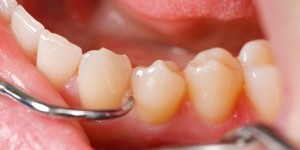
In our office we don’t have the amalgam or the metal fillings. We use a composite and it’s made of quartz and resins and it’s basically a soft material when it’s placed and then it becomes just as rigid as your tooth structure. Scientists have tried to mimic all the properties of the tooth, so that means how they respond under compressive forces, how the tooth would respond under tensile forces, which would be pulling, so we attempt to mimic the tooth as closely as possible.
So the composite exhibits many of these properties that are very, very similar to the teeth and certainly we have the ability to match the shade of the teeth. So just because they’re different shades of composite. But a filling is really just needed in a couple cases. Sometimes the patients have an actual defect on the tooth where they don’t have any decay but they have a defect, like a void or an area that needs to be filled, so the composite is just bonded to the tooth in that area.
In other cases, and most commonly, if a patient has a cavity, it’s a matter of removing the cavity and preparing that cavity in certain, very specific dimensions and then placing the filling, In the area where the patient had the cavity. In other cases, fillings can be used in aesthetic cases, to bond to the front of teeth.
If the patient has a chipped tooth or maybe the patient wants bonded veneers, so not porcelain veneers but like chair-side veneers, so that’s a situation where there isn’t a lab that’s involved so it’s not a matter of taking an impression after the veneer preps have been prepared but it’s a matter of instantly leaving the office with teeth that look more aesthetic. And so we use composites to bond chips in the front teeth, or defects, or just to fill cavities.
And as far as postoperative care, it’s really just a matter of avoiding eating anything until the anesthesia wears off. And just treating the teeth as hopefully you always do, which is keeping up with your home care.

























